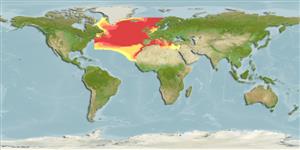Environment: milieu / climate zone / depth range / distribution range
Ecologia
marino batipelagico; oceanodromo (Ref. 51243); distribuzione batimetrica 0 - 1000 m (Ref. 35388). Deep-water; 69°N - 15°N, 67°W - 36°E
Eastern Atlantic: Mauritanian Upwelling Region (15°N-20°N) with isolates as far as 30°N; includes the Mediterranean Sea. Western Atlantic: Greenland to USA.
Length at first maturity / Size / Peso / Age
Maturity: Lm ?, range 5 - ? cm
Max length : 11.0 cm SL maschio/sesso non determinato; (Ref. 35388)
High-oceanic, mesopelagic (Ref. 4479). Nyctoepipelagic at the surface and down to 125 m and found between 225-750 m during the day (Ref. 4479). Feeds on copepods, euphausiids, zoea stages of Brachyura and fish fry (Ref. 4775). Sexually mature when 5 cm long. Female produces 8-900 eggs (Ref. 35388).
Hulley, P.A., 1990. Myctophidae. p. 398-467. In J.C. Quero, J.C. Hureau, C. Karrer, A. Post and L. Saldanha (eds.) Check-list of the fishes of the eastern tropical Atlantic (CLOFETA). JNICT, Lisbon; SEI; Paris; and UNESCO, Paris. Vol. 1. (Ref. 4479)
IUCN Red List Status (Ref. 130435: Version 2024-1)
Threat to humans
Harmless
Human uses
Strumenti
Special reports
Download XML
Fonti Internet
Estimates based on models
Preferred temperature (Ref.
123201): 3.4 - 14.6, mean 7.9 °C (based on 627 cells).
Phylogenetic diversity index (Ref.
82804): PD
50 = 0.5000 [Uniqueness, from 0.5 = low to 2.0 = high].
Bayesian length-weight: a=0.00708 (0.00370 - 0.01356), b=3.15 (2.98 - 3.32), in cm total length, based on LWR estimates for this species & (Sub)family-body (Ref.
93245).
Trophic level (Ref.
69278): 3.4 ±0.39 se; based on food items.
Generation time: 6.6 ( na - na) years. Estimated as median ln(3)/K based on 2
growth studies.
Resilienza (Ref.
120179): Medio, tempo minimo di raddoppiamento della popolazione 1.4 - 4.4 anni (Fec=800).
Fishing Vulnerability (Ref.
59153): Low to moderate vulnerability (32 of 100).
Nutrients (Ref.
124155): Calcium = 88.9 [24.1, 250.1] mg/100g; Iron = 0.499 [0.183, 1.602] mg/100g; Protein = 16.5 [14.7, 18.3] %; Omega3 = 0.311 [0.103, 0.923] g/100g; Selenium = 12.8 [3.8, 40.5] μg/100g; VitaminA = 93.7 [11.5, 765.4] μg/100g; Zinc = 0.799 [0.401, 1.698] mg/100g (wet weight);
